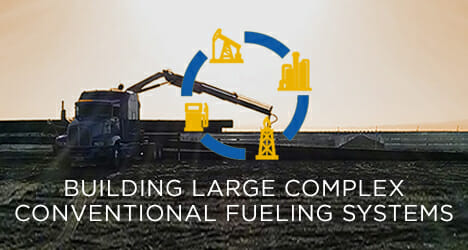Working with EPCs — End-to-End Renewable Energy Engineering Learn More
Designing fleet fueling and maintenance facilities for alternative as well as conventional fuel vehicles

Blymyer Engineers is known for our expertise in designing fleet fueling systems and maintenance facilities for conventional fuel (diesel and gasoline) vehicles. We’ve designed some of the largest and most complex conventional fueling systems ever built — including multi-story indoor systems — at Consolidated Rental Car Facilities in airports throughout the U.S.
What’s less well known, however, is that we also have extensive experience designing fueling systems and maintenance facility upgrades for alternative fuel vehicles. Alternative fuel vehicles include those using compressed natural gas (CNG) or liquefied natural gas (LNG) as the engine fuel source.
Blymyer Engineers has designed over two dozen CNG fueling systems at municipal and private facilities all over the U.S. These systems include gas compression and storage equipment, internal or retail fast-fill dispensing, and time-fill dispensing for up to 250 vehicles. They incorporate the latest code requirements and best engineering practices for safe and efficient fueling at pressures up to 4500 psi.
Maintenance of CNG- and LNG-powered vehicles is subject to special code requirements for facilities that perform major repairs. Mechanical ventilation of 1 cfm per 12 cubic feet of building volume (equivalent to 5 air changes per hour) is required continuously during occupancy, or it may be normally inactive and activated by a gas-detection system.
Gas-detection systems are required for garages performing repairs on vehicles fueled by non-odorized gases such as LNG. Existing heating systems that have open flame burners and/or surface temperatures greater than 750 degrees F must also be replaced. Special infrared tube heating systems with low-intensity burners are typically used as replacements for the existing gas-fired unit heaters commonly found in maintenance shops. As an added benefit, these infrared systems can significantly improve the quality of heat in the repair bays.
Finally, the area within 18 inches of the ceiling becomes a classified area (Class I, Division 2), and any equipment or raceways within the classified area must either be lowered below the area or meet specific electrical code requirements for location within a classified area.
Blymyer Engineers has been involved in the upgrades of over 30 CNG and LNG vehicle maintenance facilities, and we’ve continued to refine our design to provide a scope of work for each facility that ensures code compliance at the lowest possible cost.
Author: Michael Lewis is Vice President of Blymyer Engineers and is the design team manager for alternative vehicle fueling and maintenance projects. He can be contacted directly at (510) 747-3070 or mlewis@blymyer.com.